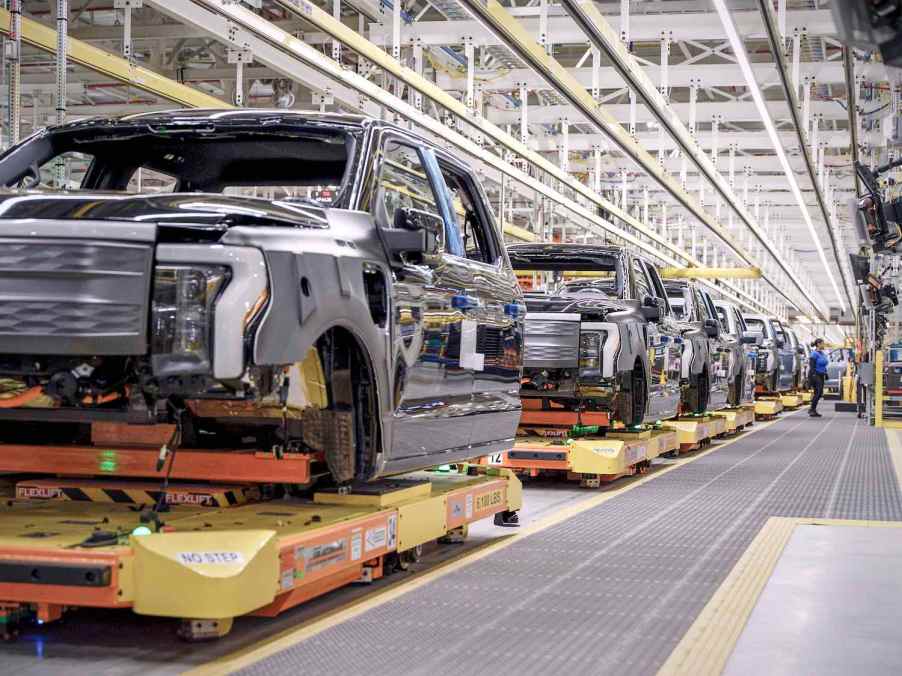
Ford Slices F-150 Lightning Production in Half Because It Was Building the Wrong EV
If you want a true full-size electric pickup truck, you really only have one option right now. That’s the Ford F-150 Lightning. But it seems that not enough buyers even want that, and Ford is cutting lightning production in half ahead of 2024. Hcere’s the truth: A sizable percentage of Americans may be driving EVs soon. But not if they look like the lightning. In fact the electric truck will be a niche product for a long time.
Electric pickup trucks are exciting. With maximum torque at zero rpm, an electric powertrain gets an off-roader’s mind racing. Couple that with feature’s like the Hummer EV’s side-steering “crabwalk” or the Rivian R1T’s “tank turn” pirouette, and you have some compelling concepts.
But even though the news is full of electric concept trucks, there aren’t many in production. You could try to get a midsize R1T from the Rivian startup, or a Hummer EV truck–a GMC special edition. Chevrolet announced its Silverado EV is in production, but then paused again–after building 18 of them. So electric enthusiasts were thrilled when Ford announced full production of the F-150 Lightning EV. Within a year, Ford added a shift to its Dearborn plant to keep up with projected demand.
Mickey Anderson owns 20 dealerships in Nebraska, Missouri and Colorado. When Ford announced the Lightning, 200 folks placed refundable preorders through his dealerships. But when the electric trucks began arriving on his lots, few of those “hand raisers” ponied up the cash. He sold 1,000 trucks last year, and just 25 of those were F-150 Lightnings. He told Axios news that he has 12 more Lightnings in stock he’s still trying to unload, with $14k in incentives offered by Ford to sweeten the deal.
“While the technology is absolutely brilliant, and I would argue world class, it doesn’t change the daily challenges that the American consumer has with an all-EV product today.”
Mickey Anderson
After all the preorders for Lightnings, Ford ramped production up to 150,000 units a year, or 3,200 each week. So far, Ford has only sold 20,000 Lightnings in 2023. So this week, it laid off the third shift at its Dearborn plant and, rumor has it, told suppliers it would drop back to 1,6000 trucks per week.
Just 1% of the vehicles on the road in the U.S. are EVs. EVs also make up 7.5% of new car sales. There’s a lot of hand-wringing over how to increase these numbers. Is it even possible?

There are many Americans, such as folks with one-car households in rural areas, who simply cannot drive an EV right now. And of course automakers recognized that and are continuing to develop and build ICE vehicles. But there is another portion of the population who might by the right EV. And obviously the F-150 Lightning is not it.
Trucks are inefficient. In the case of EVs, this means they go through a ton of electricity for every mile on the road. They also have huge battery packs which can take an hour to charge up. Sure, you can charge them at home overnight. But driving further than one range in a day becomes a real hassle. To make matters worse, hooking up to a trailer may slice an electric truck’s range in half.
Light, aerodynamic EVs have a much better kW/mile ratio. This means they can get away with lighter batteries, which makes them even more efficient. Couple that with cutting-edge 800-volt charging speeds, and you have an EV you could roadtrip indefinitely. The first gen of the Mustang Mach E didn’t hit these numbers, but a redesign could. This would make it a real competitor of Tesla and Hyundai.
So what is the future of electric trucks? Electric vehicles have so few moving parts, they can cost just pennies per mile to operate. Their “fuel” can be cheaper and they suffer less downtime. For a vehicle fleet owner, these are major benefits. Local fleet trucks, that only travel a set number of miles per day, will probably be electric surprisingly soon. But to court them, Ford needs to build a chassis/cab EV without all the bells and whistles. And that’s not the current Lightning.




